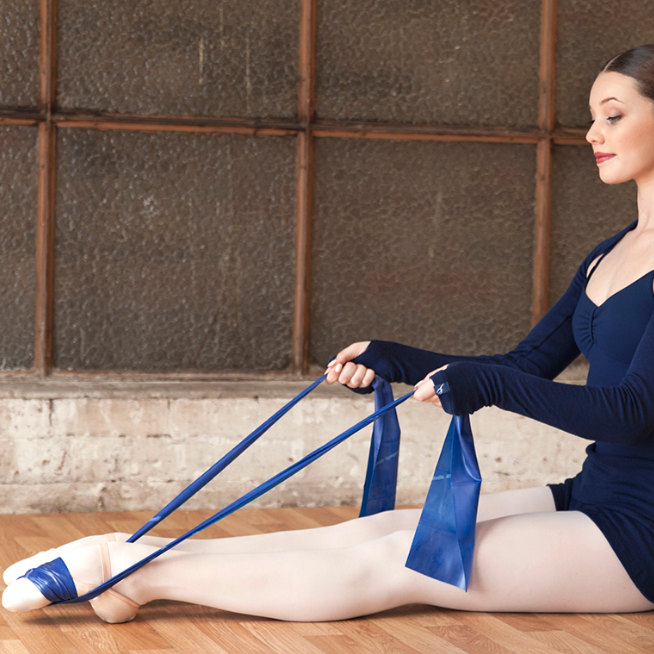Improving your pointe: 7 steps to a better arch
Dream arches in the Energetiks Pivot 360 Tech Fit shoe
There are many things on every dancers wish-list; flexibility, musicality, a nice arabesque, fast allegro, long, elegant limbs (an insensitivity to pain maybe?!), but possibly the all-time most yearned after feature for any bun-head is a beautiful pointe.
Feet have been a crucial component to the aesthetics of dance ever since Marie Taglioni brazenly went to new heights by stepping 'en pointe' during that game-changing performance of La Sylphide in the seventeenth century. Since then dancers have aspired to elongate the line of the body as much as possible, and beautifully pointed feet with a high instep and pronounced arches isn’t just an extension of that line, it’s also a point of pride amongst dancers, and a testament to the incredible specialisation of a dancer’s body (no one is born with feet like Zakharova … not even Zakharova!).
There is still a large part of your capacity for pointe that is determined by genetics though. Not every dancer is going to be blessed with the ability to get rubber-like bendy feet. However that's not to say that you can't significantly enhance what you're born with. Through gently stretching the ligaments and strengthening the muscles over time, you can enhance the instep, arch, pointe, strength and flexibility of your feet and give yourself the very best pointe possible!
Here are our top tips for improving your pointe:
1. It's all about resistance.
Whether it's the resistance you create through the floor, or artificial resistance - such as with a thera-band or by wearing pointe shoes or demi pointes during class - the more your feet have to work through the demi-pointe and articulate all the way through the intrinsic muscles of the foot the better. Note: this is very different to 'forcing it. For example, when dancers get friends to sit on their feet for extended periods of time, or wedge their toes under hard surfaces and force their knees to straighten. The logic behind this is that due to the excessive weight, this will increase your natural pointe flexibility. The truth is you can permanently damage ligaments by stretching them beyond their natural range of motion; which means rather than having better feet, you become weak and unstable on demi-pointe and pointe, and have reduced control over your feet. Always be gentle when stretching, it's much better to build up your range of movement gradually, rather than causing irreversible damage in one sitting. Be patient, it's worth it!
Check out the first few exercises in this helpful Thera-band tutorial for some great tips on resistance stretching for your feet.
2. Don't neglect the supporting leg.
Myth number #379 in dance: 'The working leg is the most important leg.' Now, I get the logic here, one leg is stationary and planted firmly on the ground whilst your other leg is precariously trying to execute seven impossible things at the same time, it's earned some favouritism, right? Well... no. When working on our pointe, dancers tend to focus only on the working leg - however, it's often what you're doing in a 'relaxed' position that plays a crucial role.
Whilst speaking on the topic of improving arches Vicki Negus, the West Australian Ballet’s resident physiotherapist notes: “[I]f you let your arch collapse when it is weight-bearing, all the bones of the arch have rolled in and will get strong in that rolled position. If you lift your arch when you are standing on it, you are strengthening it in the correct position.” The stronger you build these muscles and the rest of the foot's muscles, the greater control you'll have over the articulation of the foot and the shape of the extended pointe. So keep checking yourself in class and at home, even the worst foot-roller can (with enough determination) overcome their bad habits and make pulled up, engaged muscles a reflex just as natural as breathing.
3. Use your eccentric movements.
*Note: Not the same as the other kind of 'eccentric' ...although eccentric dancing can be fun too.
Every movement is made up of two stages. There's the concentric stage, which is the 'action' part of a move; for example the extension part of a tendu, or the 'sitting up' part of a sit-up. And then there's the eccentric part, which is when the muscles involved in the movement (that just contracted to allow the action to take place) must elongate again to return the body to it's resting state (ie. the closing portion of a tendu, and the laying-back-down part of a sit-up). The misconception is that muscles that are moving eccentricly can't really be 'worked', they're just passive - like when the leg is returning from a grand battement. However the energy and power it takes to lower the leg with control and replace it in the required fifth position takes an incredible amount of work, and taking advantage of this stage of each exercise will improve every aspect of your dancing to no end. If you want to know just how much control you have of your body's eccentric movements try landing completely silently from a jump, it's eccentric control that allows you to land without a big 'thud', and it's the eccentric phase of a movement that is so crucial to building strength and control. Focusing on working the muscles of the foot through the eccentric stage of each exercise will give you much greater control and manipulation over your pointe.
4. Fake it.
No this isn't us advocating getting 'arch implants' or anything crazy like that (that was a joke, but let's be honest it's probably a thing somewhere...). Short of actually breaking your feet, the best way to improve your articulation and enhance the instep is to 'fake' great articulation. Just think, if you had the MOST incredibly supple, bendy, fluid feet with incredible arches, you would take advantage of every single count of music and every développé to show them off, wouldn't you? From now on, when you're in class try visualising the exact feet you would like and maintaining that perception all through class - treat every exercise like a chance to show them off. This way you'll be working through the feet as much as possible, which will have your feet getting stronger and more pliable in no time. Whilst at first this kind of concentrated focus might take a lot of effort, having the discipline to isolate your muscles like this will build muscle memory of the feel and routine of properly working and engaging your feet, and eventually proper articulation will become second nature.
5. Expand your focus.
If you want to make significant improvements to your pointe, you can't just focus on the muscles in the feet, you want to build strength and stability in all the muscles that are involved in the process of plantar flexion (ie. 'pointing').
The muscles that should be focused on are these muscles of the posterior calf:
Source: http://images.slideplayer.com/14/4311227/slides/slide_15.jpg
Gastrocnemius
Soleus
Tibialis posterior
Flexor hallucis longus/brevis
Flexor digitorum longus/brevis
Peroneus longus/brevis
This stretching and strengthening exercise for feet and calves is a good way to work through these muscles in unison:
Calf raises through plié
With your feet in parallel, standing at the barre or near a table or chair for balance, bend into a demi plie keeping the knees directly over the toes.
Whilst in the plie position, gradually lift your heels off the ground, rolling up through the intrinsic muscles of the foot and extending to your highest demi-pointe.
Keeping the heels as lifted as possible, straighten the knees so you’re standing in a turned in first position on demi pointe.
Now slowly lower the heels returning to a relaxed position. Repeat several times, then perform with the feet in first and second position.
Finally, repeat the whole process in reverse, starting with a rise onto demi-pointe, then gradually bending the knees to a demi plie-level, and (working the feet as much as possible) slowly lowering the heels, maintaining the plie, before finally straightening.
6. Consistency.
Giving yourself the most thorough foot workout is wonderful of course, but even the best stretching session isn't going to do you any good if you don't follow through. It's not enough to concentrate on your feet once a month, or once a week. If you really want to see improvements you've got to think about your feet each time you're in class and continue doing exercises and strengthening your feet and ankle muscles daily. The more consistent you can be with your habits the better the results you'll have.
Also - Don't forget to balance out all this extra training, you need to ensure that an increase in muscle use doesn't lead to stiff, tight calves which will end up impeding your dancing. Here's a great video with some exercises to release your calves and activate the gluteal muscles to restore some balance to your training: Calf release and glute activation for dancers.
...And finally, our last tip:
7. Balance is key.
Always, always, always aim for a balance between strength and flexibility. It's so important to understand the complementary role these two play; there's no use being able to bend your toes to the floor if you can't hold them there without wedging your feet under the couch. Just like there's no point being able to do splits if you don't have the muscles to lift and support the leg in a Penché. Flexibility is like a key, it gives you the potential to be able to do something specific. However it's strength that gives you the ability to execute that potential. The only way to really improve your feet, is if you have enough strength to control the additional pliancy you've gained through stretching.
Slow, controlled rises through the demi pointe, first with both feet and then on a single supporting leg is a great exercise to incorporate into your warm-up. Remember to be just as conscious of your technique and control during the eccentric (lowering) part of the exercise.
So there you have it, we hope this advice has helped you not just improve your pointe, but to also understand how certain exercises benefit the body (as well as what things don't) so that you can make safe decisions with your dance training and avoid unnecessary injury. Keep practising and improving your range of movement and you can look forward to a whole new pointe.
Happy dancing!
Need some help with your turnout too? We've got that sorted too. Here's everything you need to know to improve your turnout: Turning out better.
Article by Elly Ford










